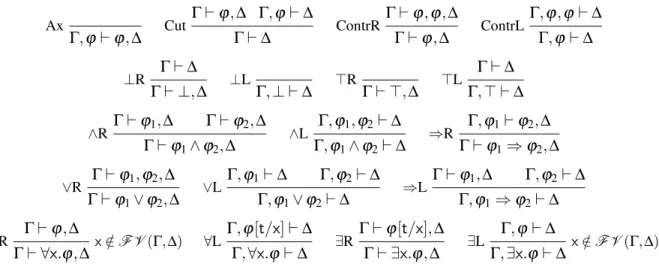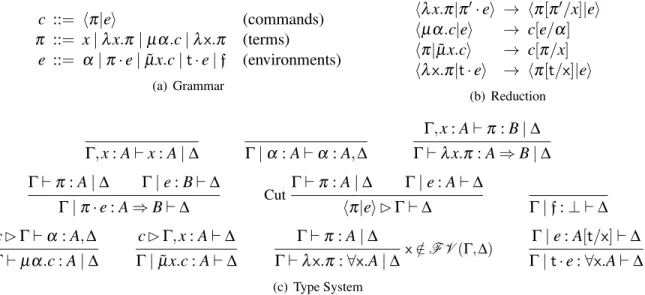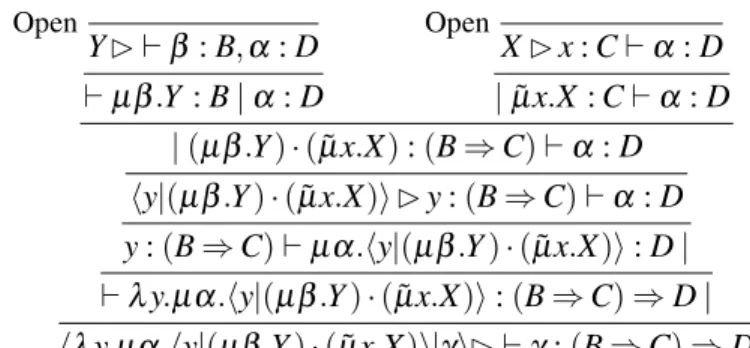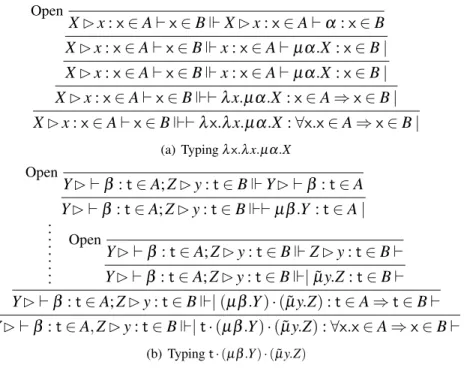Steffen van Bakel, Stefano Berardi, Ulrich Berger (Eds.): Classical Logic and Computation 2010 (Cl&C’10) EPTCS 47, 2011, pp. 34–43, doi:10.4204/EPTCS.47.5
c
C. Houtmann
This work is licensed under the Creative Commons Attribution License. Clément Houtmann
INRIA Saclay - Île de France and LIX/École Polytechnique, 91128 Palaiseau Cedex
Clement.Houtmann@inria.fr
Superdeduction is a method specially designed to ease the use of first-order theories in predicate logic. The theory is used to enrich the deduction system with new deduction rules in a systematic, correct and complete way. A proof-term language and a cut-elimination reduction already exist for superdeduction, both based on Christian Urban’s work on classical sequent calculus. However the computational content of Christian Urban’s calculus is not directly related to the (λ-calculus based) Curry-Howard correspondence. In contrast theλ µµ-calculus is a˜ λ-calculus for classical sequent calculus. This short paper is a first step towards a further exploration of the computational content of superdeduction proofs, for we extend theλ µµ-calculus in order to obtain a proofterm langage˜ together with a cut-elimination reduction for superdeduction. We also prove strong normalisation for this extension of theλ µµ-calculus.˜
Keywords: Classical sequent calculus, Superdeduction,λ µµ-calculus˜
1
Introduction
Superdeduction is an extension of predicate logic designed to ease the use of first-order theories by
enriching a deduction system with new deduction rules computed from the theory. Once the theory is pre-sented as a rewrite system, the translation into a set of custom (super)deduction rules is fully systematic. Superdeduction systems [1] are usually constructed on top of the classical sequent calculus LK which is described in Figure 1. New deduction rules are computed from a theory presented as a set ofproposition rewrite rules, i.e. rewrite rules of the formP→ϕ wherePis some atomic formula. Such rewrite rules
actually stand for equivalences∀x.(P⇔ϕ)wherexrepresents the free variables ofP. The computation
of custom inferences for the proposition rewrite ruleP→ϕgoes as follows. On the right, the algorithm decomposes (bottom-up) the sequent⊢ϕ using LK\{Cut,ContrR,ContrL}(non-deterministically) until it reaches a sequence of atomic sequents1(Γ
i⊢∆i)16i6n. During this decomposition, each application of ∃L and∀R corresponds to a side condition x∈/F V(ϒ)for some first-order variablexand for some list of formulaϒ. This particular decomposition of⊢ϕthen leads to the inference rule
(Γ,Γi⊢∆i,∆)16i6n Γ⊢P,∆ C
for introducingPon the right whereCis the conjunction of the side conditions. On the left, the
algo-rithm similarly decomposes ϕ ⊢ until it reaches a sequence of atomic sequents (Γ′
j⊢∆′j)16j6m and a conjunction of side conditionsC′yielding similarly the inference rule
(Γ,Γ′j⊢∆′j,∆)16j6m Γ,P⊢∆ C
′ .
Ax
Γ,ϕ⊢ϕ,∆ Cut
Γ⊢ϕ,∆ Γ,ϕ⊢∆
Γ⊢∆ ContrR
Γ⊢ϕ,ϕ,∆
Γ⊢ϕ,∆ ContrL
Γ,ϕ,ϕ⊢∆ Γ,ϕ⊢∆
⊥R Γ⊢∆
Γ⊢ ⊥,∆ ⊥L Γ,⊥ ⊢∆ ⊤R Γ⊢ ⊤,∆ ⊤L
Γ⊢∆ Γ,⊤ ⊢∆
∧R Γ⊢ϕ1,∆ Γ⊢ϕ2,∆ Γ⊢ϕ1∧ϕ2,∆
∧L Γ,ϕ1,ϕ2⊢∆ Γ,ϕ1∧ϕ2⊢∆
⇒R Γ,ϕ1⊢ϕ2,∆ Γ⊢ϕ1⇒ϕ2,∆
∨R Γ⊢ϕ1,ϕ2,∆ Γ⊢ϕ1∨ϕ2,∆ ∨L
Γ,ϕ1⊢∆ Γ,ϕ2⊢∆ Γ,ϕ1∨ϕ2⊢∆ ⇒L
Γ⊢ϕ1,∆ Γ,ϕ2⊢∆ Γ,ϕ1⇒ϕ2⊢∆
∀R Γ⊢ϕ,∆ Γ⊢ ∀x.ϕ,∆x∈/
F V(Γ,∆) ∀LΓ,ϕ[t/x]⊢∆
Γ,∀x.ϕ⊢∆ ∃R
Γ⊢ϕ[t/x],∆
Γ⊢ ∃x.ϕ,∆ ∃L
Γ,ϕ⊢∆ Γ,∃x.ϕ⊢∆x∈/
F V(Γ,∆)
Figure 1: Classical Sequent Calculus LK
As remarked in [7], this non-deterministic algorithm may return several inference rules for introducing
Prespectively on the right or on the left. One must add all the possible inference rules in order to obtain
a complete superdeduction system.
Definition 1(Superdeduction systems [1]). IfRis a set of proposition rewrite rules, the superdeduction
system associated withRis obtained by adding to LK all the inferences which can be computed from the
elements ofR.
The paradigmatic example for superdeduction is the system associated with the proposition rewrite ruleA⊆B → ∀x.(x∈A⇒x∈B)which defines the inclusion predicate ⊆. This rewrite rule yields inference rules
Γ,x∈A⊢x∈B,∆
Γ⊢A⊆B,∆ x∈/F V(Γ,∆) and
Γ,t∈B⊢∆ Γ⊢t∈A,∆ Γ,A⊆B⊢∆ .
As demonstrated in [1], superdeduction systems are always soundw.r.t. predicate logic.
Complete-ness is ensured whenever right-hand sides of proposition rewrite rules do not alternate quantifiers2. Cut-elimination is more difficult to obtain: several counterexamples are displayed in [8]. We have proved in [7] that whenever right-hand sides of proposition rewrite rules do not contain universal quantifiers and ex-istential quantifiers at the same time3, cut-elimination in superdeduction is equivalent to cut-elimination indeduction modulo(another formalism which removes computational arguments from proofs by
rea-soning modulo rewriting on propositions [6]).
In the original paper introducing superdeduction [1], a proof-term language and a cut-elimination reduction are defined for superdeduction, both based on Christian Urban’s work on classical sequent calculus [13]. The reduction is proved to be strongly normalising on well-typed terms when the set of proposition rewrite rulesRsatisfies the following hypothesis.
Hypothesis 1. The rewriting relation associated with R is weakly normalising and confluent and no
first-order function symbol appears in the left-hand sides of proposition rewrite rules ofR.
c ::= hπ|ei (commands) π ::= x|λx.π|µα.c|λx.π (terms)
e ::= α |π·e|µ˜x.c|t·e|f (environments)
(a) Grammar
hλx.π|π′·ei → hπ[π′/x]|ei hµα.c|ei → c[e/α]
hπ|µ˜x.ci → c[π/x]
hλx.π|t·ei → hπ[t/x]|ei (b) Reduction
Γ,x:A⊢x:A|∆ Γ|α:A⊢α :A,∆
Γ,x:A⊢π:B|∆ Γ⊢λx.π:A⇒B|∆ Γ⊢π:A|∆ Γ|e:B⊢∆
Γ|π·e:A⇒B⊢∆ Cut
Γ⊢π:A|∆ Γ|e:A⊢∆
hπ|ei⊲Γ⊢∆ Γ|f:⊥ ⊢∆
c⊲Γ⊢α :A,∆ Γ⊢µα.c:A|∆
c⊲Γ,x:A⊢∆ Γ|µ˜x.c:A⊢∆
Γ⊢π:A|∆
Γ⊢λx.π:∀x.A|∆x∈/F V(Γ,∆)
Γ|e:A[t/x]⊢∆ Γ|t·e:∀x.A⊢∆ (c) Type System
Figure 2: Theλ µµ˜-calculus
The computational content of Christian Urban’s calculus is not directly related to the (functional) Curry-Howard correspondence whereas theλ µµ˜-calculus [4] is a λ-calculus for sequent calculus. In order to explore the computational content of superdeduction inferences, we will define in Section 2 an extension of theλ µµ˜-calculus for superdeduction systems and prove the same strong normalisation result using Hypothesis 1. But before doing so, let us recall the definition of theλ µµ˜-calculus.
The λ µµ˜-calculus is defined as follows. In order to avoid confusion between first-order variables
andλ µµ˜ variables, we will use sans-serif symbols for first-order variables (x,y. . .) and first-order terms
(t,u. . .). Commands, terms and environments are respectively defined by the grammar in Figure 2(a).
The type system is described in Figure 2(c). Reduction rules are depicted in Figure 2(b). We have added a constant environment fin order to realise falsity. We also have added constructions λx.π and t·ein
order to realise universal quantifications respectively on the right and on the left. Implication, universal quantification and falsity are sufficient to express all the connectives in LK. The typing rules
FocusR Γ⊢π:A|∆
hπ|αi⊲Γ⊢α :A,∆ and FocusL
Γ|e:A⊢∆ hx|ei⊲Γ,x:A⊢∆
are admissible in the type system of Figure 2(c). Replacing the Cut rule by FocusR and FocusL yields a type system that we will callcut-freeλ µµ˜. It is obviously not equivalent to the original type system in
Figure 2(c). The reduction relation defined in Figure 2(b) is strongly normalising on well-typed terms as demonstrated in [12].
Notations. Sequences(ai)16i6nmay be denoted(ai)ior just ¯awhen the upper boundncan be retrieved
from the context (or is irrelevant). Both notations may even be combined:(a¯i)i represents a sequence of sequences((aj,i)16j6mi)16i6n. Finally ifΓ= (Ai)iand ¯x= (xi)iare respectively a sequence ofnformulæ
2
Extending
λ µ
µ
˜
In the paper introducing superdeduction [1], Christian Urban’s calculus is presented as a better choice than theλ µµ˜-calculus for a basis of a proofterm language for superdeduction. In this section, we refute this claim and demonstrate that theλ µµ˜-calculus is as suitable as Christian Urban’s calculus. Such an extension is a first step towards a Curry-Howard based computational interpretation of superdeduction, since the λ µµ˜-calculus relates directly to the λ-calculus. An inaccuracy of the original paper [1] is also corrected in the process. The extension of theλ µµ˜-calculus that we will present corrects this mis-take. The imprecision concerns first-order quantifications. Indeed a superdeduction inference represents an open derivation which may contain several quantifier destructions. The structure organizing these destructions is essential to the definition of the underlying cut-elimination mechanisms. For instance a sequence ∀∃ on the right corresponds to the creation of an eigenvariable, say x, followed by an
in-stantiation by some first-order term, say t, which may containxas a free variable. A sequence∃∀ on
the right corresponds to an instantiation by some first-order term, sayt, followed by the creation of an
eigenvariable, sayx. In this latter case, t is not allowed to containx as a free variable. This
distinc-tion is completely erased in the syntax of the original extension [1]. It results in an imprecision of the scope of eigenvariables in extended proofterms: the scope is not explicit in the syntax. In our extension of the λ µµ˜-calculus, this syntactical imprecision is corrected by introducing a notion of trace which
represents the correct syntax for a precise syntactical representation of the scopes of eigenvariables in extended proofterms. Then we present a correct cut-elimination procedure by introducing a notion of in-terpretationfor the constructs of the extendedλ µµ˜-calculus relating such constructs toλ µµ˜ proofterms
in a correct way. At the end of the section, a pathological example is depicted to illustrate the imprecision of the original extension [1] and the correction of the present extension.
First, let us consider any derivation in LK, potentially unfinished, i.e. with leaves that remain
un-proven. Since such a derivation is a tree, there exists a natural partial order on its inferences: an inference precedes another if the former is placed under the latter. Such a partial order can easily be extended into a total order (in a non-deterministic way). Considering only instances of∀R,∀L,∃R and∃L, such a total order returns a listLof such instances. Each instance of∀R or∃L corresponds to the use of an eigenvari-able, sayx. Such a use will be denotedx?. Each instance of∀L or∃R corresponds to the instantiation of
some first-order variable by a first-order term, sayt. Such a use will be denotedt!. The listLbecomes
a list whose elements are either of the form x? or of the form t!. Such a list is called a trace for the
derivation.
Let us consider a proposition rewrite ruler:P→ϕleading to the superdeduction inferences
(Γ,Γi⊢∆i,∆)i
Γ⊢P,∆ C and
(Γ,Γ′j⊢∆′j,∆)j Γ,P⊢∆ C
′ .
Let us consider the first one. Since it is derived from inferences of LK, there exists a derivation of⊢ϕ with open leaves(Γi⊢∆i)i in LK [8, Property 6.1.3]. Let L be a trace for this derivation. Then the superdeduction inference introducingPon the right is turned into the typing rule
rR (ci⊲Γ,xi:Γi⊢αi:∆i,∆)i Γ⊢r(L,(µi(xi,αi).ci)i):P|∆
C .
superdeduction inference introducingPon the left which is turned into the typing rule
rL (c ′
j⊲Γ,yj :Γ′j⊢βj:∆′j,∆)j Γ|r(L′,(µ˜j(yj,βj).c′j)j):P⊢∆
C′ .
Here variablesyj and βj are bound inc′j for each j. For example, the inference rules for⊆are turned into
c⊲Γ,x:x∈A⊢α:x∈B,∆
Γ⊢r(x?,µ(x,α).c):A⊆B,∆x∈/F V(Γ,∆) and
c1⊲Γ,x:t∈B⊢∆ c2⊲Γ⊢α :t∈A,∆ Γ,r(t!,µ˜1(x).c1,µ˜2(α).c2):A⊆B⊢∆ .
IfRis a set of proposition rewrite rules, the type system resulting of extending the type system of Figure 2(c) with the typing rules forRis denotedλ µµ˜R.
We must now define how cuts of the form
hr(L,(µi(xi,αi).ci)i)|r(L′,(µ˜j(yj,βj).c′j)j)i
are reduced. Such reductions are computed usingopenλ µµ˜, a type system for derivations with open
leaves4in theλ µµ˜-calculus type system. An open leaf is represented by avariable command(symbols
X,Y. . .). The types of such variables have the same shape as the types of usual commands inλ µµ˜ -calculus: full sequentsΓ⊢∆. Therefore typing in openλ µµ˜ is performed in a contextΘwhich contains a list of typed variable commands of the formX⊲Γ⊢∆. As usual, variable commands are allowed to appear only once in such contexts. Typing judgements are denoted
Θc⊲Γ⊢∆ when typing a command; ΘΓ⊢π:A|∆ when typing a term
and ΘΓ|e:A⊢∆ when typing an environment.
Openλ µµ˜ is obtained by extending cut-freeλ µµ˜ to such judgements and by adding the typing rule
Open
Θ;X⊲SX⊲S .
For example, Figure 3 contains a derivation of
X⊲x:C⊢α:D;Y⊲⊢α :D,β :Bhλy.µα.hy|(µβ.Y)·(µ˜x.X)i|γi ⊲ (⊢γ:(B⇒C)⇒D).
(where the prefixX⊲x:C⊢α :D;Y⊲⊢α:D,β :Bis omitted for readability.)
The reduction in Figure 2(b) is extended to openλ µµ˜ by simply defining how subtitutions behave on command variables (X[t/x],X[e/α]orX[t/x]): they are turned intodelayed substitutions, i.e. syntactic
constructions, denoted X{t/x}, X{e/α} orX{t/x}, which will be turned back into primitive
substitu-tions onceXis instanciated.
A typing derivation in openλ µµ˜ obviously corresponds to a derivation in LK (with open leaves). If
Kis a typed command, term or environment, then a trace for K is a trace for the derivation corresponding
toK. Let us reconsider our extended terms
r(L,(µi(xi,αi).ci)i) and r(L′,(µ˜j(xj,αj).c′j)j)
Open
Y⊲⊢β :B,α:D
⊢µβ.Y :B|α:D
Open
X⊲x:C⊢α:D
|µ˜x.X:C⊢α:D
|(µβ.Y)·(µ˜x.X):(B⇒C)⊢α :D
hy|(µβ.Y)·(µ˜x.X)i⊲y:(B⇒C)⊢α:D y:(B⇒C)⊢µα.hy|(µβ.Y)·(µ˜x.X)i:D| ⊢λy.µα.hy|(µβ.Y)·(µ˜x.X)i:(B⇒C)⇒D| hλy.µα.hy|(µβ.Y)·(µ˜x.X)i|γi⊲⊢γ:(B⇒C)⇒D
Figure 3: Typing in openλ µµ˜
and their respective typing rules rR and rL. The sets
e
rR=
π . (Xi⊲(xi:Γi⊢αi:∆i))i ⊢π:ϕwell-typed in openλ µµ˜ andLis a trace forπ
and
e
rL=
e
. (Y
j⊲(yj:Γ′j⊢βj:∆′j))j e:ϕ⊢ well-typed in openλ µµ˜ andL′is a trace fore
are both non-empty: Indeed by construction of the superdeduction inference rules, we know that there exists a derivation in LK of ⊢ϕ (resp. ϕ ⊢) from premisses (Γi ⊢∆i)i (resp. (Γ′j ⊢∆′j)j) such that
L (resp. L′) is a trace for this derivation. Therefore by logical completeness of (open) λ µµ˜, there
exists at least one term inrR (resp. one environment ine rL). Each terme π∈rR intuitively representse
r(L,(µi(xi,αi).Xi)i)in openλ µµ˜. Each environmente∈rL intuitively representse r(L′,(µ˜j(xj,αj).c′j)j) in openλ µµ˜. Therefore wheneverπandeare respectively inrR ande rL, any normal forme hπ|eican be chosen as a direct reduct of
h r(L,(µi(xi,αi).ci)i) | r(L′,(µ˜j(xj,αj).c′j)j) i.
We suppose that for each typing rule rR (resp. rL) one specific π ∈rR (resp. one specifice e∈rL) ise distinguished. This term (resp. this environment) is called the interpretation of r(L,(µi(xi,αi).Xi)i) (resp. r(L′,(µ˜j(xj,αj).Yj)j)). Then for each normal formcofhπ|ei, the rule
h(r(L,(µi(xi,αi).ci)i)|r(L′,(µ˜j(yj,βj).c′j)j)i → c[(ci/Xi)i,(c′j/Yj)j]
is added to the cut-elimination reduction (delayed substitutions{·/·}are replaced incby primitive
sub-stitutions[·/·]).
Let us reconsider the inclusion example. The termπ=λx.λx.µα.X is a potential interpretation of r(x?,µ(x,α).c). Indeed
X⊲x:x∈A⊢x∈B⊢π:∀x.x∈A⇒x∈B|
is well-typed in openλ µµ˜ as demonstrated in Figure 4(a) andx? is a trace for π. The environment e=t·(µβ.Y)·(µ˜y.Z)is a potential interpretation ofr(t!,µ˜1(y).c1,µ˜2(β).c2). Indeed
X⊲x:x∈A⊢x∈BX⊲x:x∈A⊢α:x∈B X⊲x:x∈A⊢x∈Bx:x∈A⊢µα.X:x∈B|
X⊲x:x∈A⊢x∈Bx:x∈A⊢µα.X:x∈B|
X⊲x:x∈A⊢x∈B⊢λx.µα.X :x∈A⇒x∈B|
X⊲x:x∈A⊢x∈B⊢λx.λx.µα.X :∀x.x∈A⇒x∈B| (a) Typingλx.λx.µα.X
Open
Y⊲⊢β :t∈A;Z⊲y:t∈BY⊲⊢β :t∈A Y⊲⊢β :t∈A;Z⊲y:t∈B⊢µβ.Y :t∈A| ··
·· ·· ·· ·
Open
Y⊲⊢β :t∈A;Z⊲y:t∈BZ⊲y:t∈B⊢
Y⊲⊢β :t∈A;Z⊲y:t∈B|µ˜y.Z:t∈B⊢
Y⊲⊢β :t∈A;Z⊲y:t∈B|(µβ.Y)·(µ˜y.Z):t∈A⇒t∈B⊢
Y⊲⊢β:t∈A,Z⊲y:t∈B|t·(µβ.Y)·(µ˜y.Z):∀x.x∈A⇒x∈B⊢ (b) Typingt·(µβ.Y)·(µ˜y.Z)
Figure 4: Typing interpretations for inclusion
is well-typed in openλ µµ˜ as demonstrated in Figure 4(b) andt! is a trace fore. The cut
hλx.λx.µα.X|t·(µβ.Y)·(µ˜y.Z)i has two normal forms, namely
X{t/x}{(µβ.Y)/x}{µ˜y.Z/α} and Z{µα.X{t/x}{(µβ.Y)/x}/y}.
Therefore a cut
hr(x?,µ(x,α).c)|r(t!,µ˜1(y).c1,µ˜2(β).c2)i reduces to
c[t/x][(µβ.c2)/x][µ˜y.c1/α] and c1[µα.c[t/x][(µβ.c2)/x]/y].
IfRis a set of proposition rewrite rules, the reduction relation of Figure 2(b) extended by the reduc-tion rules forRwill be denoted→
λ µµ˜R.
Theorem 1 (Subject Reduction). For all R, typability in λ µµ˜R is preserved by reduction through
→λ µµ˜R.
Proof. The only case worth considering is a reduction of somesupercut
hr(L,(µi(xi,αi).ci)i)|r(L′,(µ˜j(yj,βj).c′j)j)i.
Ifπ and eare the respective interpretations ofr(L,(µi(xi,αi).Xi)i)and r(L′,(µ˜j(yj,βj).Yj)j)andcis a normal form ofhπ|ei, then the supercut reduces toc[(ci/Xi)i,(c′j/Yj)j]. By definition of the interpre-tations, the judgements (Xi⊲(xi:Γi⊢αi:∆i))i⊢π:ϕ and (Yj⊲(yj :Γ′j ⊢βj :∆′j))je:ϕ⊢are well-typed in openλ µµ˜. Therefore by subject reduction in openλ µµ˜
is also well-typed in openλ µµ˜. Then a simple substitution lemma on command variables5 proves that if the command
hr(L,(µi(xi,αi).ci)i)|r(L′,(µ˜j(yj,βj).c′j)j)i
has a certain type, then so does the commandc[(ci/Xi)i,(c′j/Yj)j].
Theorem 2(Strong Normalisation). For allR satisfying hypothesis 1,→
λ µµ˜R is strongly normalising
on commands, terms and environments that are well-typed inλ µµ˜R.
Proof. Hypothesis 1 implies that any formulaϕ has a unique normal form forR that we denoteϕ↓p. Let us denote→e the rewrite relation defined by replacing extended terms for superdeduction by their interpretations.
r(L,(µi(xi,αi).ci)i) →e π[ci/Xi]
r(L′,(µ˜j(yj,βj).c′j)j) →e e[c′j/Yj] . . .
Such a rewrite relation is strongly normalising and confluent, therefore yielding for any extended com-mand c, term π or environment e a normal form denoted c↓e, π↓e of e↓e. Such normal forms are rawλ µµ˜ commands, terms or environments. Strong normalisation of our extended cut-elimination re-duction comes from the facts that 1. c⊲Γ⊢∆ well-typed in our extended type system implies that
c↓e⊲(Γ)↓p⊢(∆)↓pwell-typed inλ µµ˜ ;2.Γ⊢π:A|∆well-typed in our extended type system implies that(Γ)↓p⊢π↓e:A↓p|(∆)↓pwell-typed inλ µµ˜ ;3.Γ|e:A⊢∆well-typed in our extended type system implies that (Γ)↓p|e↓e:A↓p⊢(∆)↓p well-typed in λ µµ˜ ; 4. c→c′ implies c↓e→+c′↓e 5. π →π′ implies π↓e→+ π′↓e 6. e→e′ impliese↓e→+e′↓e. The hypothesis on first-order function symbols (see Hypothesis 1) is crucial in establishing points 1 to 3: indeed for any formulaϕand any first-order substitutionσ, it must be the case that(ϕ↓p)σ= (ϕσ)↓p. These six points (combined with Theorem 1) demonstrate that through↓e and↓p, theλ µµ˜-calculus simulates our extended calculus: any well-typed reduction in our extended calculus induces through↓e and↓p a longer well-typed reduction in λ µµ˜. Strong normalisation ofλ µµ˜ therefore implies strong normalisation of our extended reduction.
The end of this section is dedicated to a pathological example for superdeduction: the proposition rewrite rule
r : P→(∃x1.∀x2.A(x1,x2))∨(∃y1.∀y2.B(y1,y2))
whosemost generalsuperdeduction rules are
Γ⊢A(t,x2),B(u,y2),∆ Γ⊢P,∆
x2∈/F V(Γ,∆,u) y2∈/F V(Γ,∆) and
Γ⊢A(t,x2),B(u,y2),∆ Γ⊢P,∆
x2∈/F V(Γ,∆)
y2∈/F V(Γ,∆,t) .
The original proofterm extension [1] transforms these two inferences into a unique proofterm
rR(λx2.λy2.(λα.λβ.m),t,u,γ). It is obviously inaccurate with respect to the scope of x2 and y2: in the proofterm there is no mention that eithertis not in the scope ofy2oruis not in the scope ofx2. This fact is not reflected in the pure syntax but in the typing rules
m⊲Γ⊢α :A(t,x2),β :B(u,y2),∆
rR(λx2.λy2.(λα.λβ.m),t,u,γ)⊲Γ⊢γ:P,∆
x2∈/F V(Γ,∆,u) y2∈/F V(Γ,∆)
and
m⊲Γ⊢α :A(t,x2),β :B(u,y2),∆
rR(λx2.λy2.(λα.λβ.m),t,u,γ)⊲Γ⊢γ:P,∆
x2∈/F V(Γ,∆)
y2∈/F V(Γ,∆,t) .
Let us see how this mistake is corrected in our extension of theλ µµ˜-calculus. Traces for the superde-duction inferences are respectivelyu!y2?t!x2? andt!x2?u!y2?. These traces clearly specify that whether
tis not in the scope ofy2oru is not in the scope ofx2. Our extension of the λ µµ˜-calculus translates these superdeduction inferences into the typing rules
c⊲Γ⊢α :A(t,x2),β :B(u,y2),∆ Γ⊢r(u!y2?t!x2?,µ(α,β).c):P|∆
x2∈/F V(Γ,∆,u) y2∈/F V(Γ,∆)
and
c⊲Γ⊢α:A(t,x2),β :B(u,y2),∆ Γ⊢r(t!x2?u!y2?,µ(α,β).c):P|∆
x2∈/F V(Γ,∆)
y2∈/F V(Γ,∆,t) .
The proofterms (and the typing rules) reflect the scope of the eigenvariables. The interpretation of r(u!y2?t!x2?,µ(α,β).c) is by definition a term well-typed in λ µµ˜ whose trace isu!y2?t!x2? and the
interpretation of r(t!x2?u!y2?,µ(α,β).c) is by definition a term well-typed in λ µµ˜ whose trace is
t!x2?u!y2?. This trace restriction implies that r(u!y2?t!x2?,µ(α,β).c) and r(t!x2?u!y2?,µ(α,β).c) behave differently with respect to cut-elimination.
3
Conclusion
This extension of the λ µµ˜-calculus is a first step towards a computational interpretation of superde-duction. Indeed it refutes the idea [1] that Christian Urban’s calculus is a better basis for a proofterm language for superdeduction:λ µµ˜ syntax, typing and reduction is as suitable as Christian Urban’s calcu-lus for superdeduction. The extension presented in this short paper is almost a mechanical transcription of the original extension [1]. It relates superdeduction more closely to the λ-calculus based Curry-Howard correspondence without exploring any further the computational content of cut-elimination for superdeduction.
We believe that one of the key ingredients towards this goal is pattern-matching. Indeed superde-duction systems historically come fromsupernatural deduction [14], an extension of natural deduction
designed to type the rewriting-calculus (a.k.a.ρ-calculus) [3]. Supernatural deduction turns proposition
rewrite rules of the form
r : P → ∀x¯.((A1∧A2. . .An)⇒C) into inference rules for natural deduction
Γ,A1. . .An⊢C Γ⊢P x¯∈/
F V(Γ)
and
Γ⊢P (Γ⊢Ai[¯t/x¯])i Γ⊢C[t¯/x¯] .
(The first rule is an introduction rule and the second is an elimination rule.) The rewriting calculus is an extension of the λ-calculus where rewrite rules replace lambda-abstractions. The idea underlying the relation between supernatural deduction and rewriting calculus is that the proposition rewrite ruler
corresponds to a specific patternr(x¯,x1. . .xn). The introduction rule types an abstraction on this pattern (i.e.a rewrite rule)
Γ,x1:A1. . .xn:An⊢π:C Γ⊢r(x¯,x1. . .xn)→π:P
¯
x∈/F V(Γ)
Dually the elimination rule types an application on this pattern
Γ⊢π:P (Γ⊢πi:Ai[¯t/x¯])i Γ⊢πr(¯t,π1. . .πn):C .
Supernatural deduction systems (in intuitionistic natural deduction) have later been transformed into superdeduction systems (in classical sequent calculus) in order to handle more general proposition rewrite rules. This transformation from supernatural deduction to superdeduction systems should not break the relation with pattern matching. Indeed cut-elimination in sequent calculus relates to pattern matching [2]. Recent analysis shows that the duality between patterns and terms reflects the duality be-tween phases in focused proof systems [15]. Finally we demonstrated [7, 8] that superdeduction systems share strong similarities with focused proof systems such as LKF [9, 10], a focused sequent calculus for classical logic. Answers should naturally arise from the study of the computational content of such focused systems [11, 5].
References
[1] Paul Brauner, Clément Houtmann & Claude Kirchner (2007): Principles of Superdeduction. In: LICS, pp.
41–50.
[2] Serenella Cerrito & Delia Kesner (2004):Pattern matching as cut elimination.Theor. Comput. Sci.323(1-3),
pp. 71–127.
[3] Horatiu Cirstea & Claude Kirchner (2001): The rewriting calculus –- Part I and II. Logic Journal of the Interest Group in Pure and Applied Logics9(3), pp. 427–498.
[4] Pierre-Louis Curien & Hugo Herbelin (2000):The duality of computation. In:ICFP, pp. 233–243.
[5] Pierre-Louis Curien & Guillaume Munch-Maccagnoni (2010): The duality of computation under focus. In: IFIP TCS. Accepted.
[6] Gilles Dowek, Thérèse Hardin & Claude Kirchner (2003):Theorem Proving Modulo.Journal of Automated Reasoning31(1), pp. 33–72.
[7] Clément Houtmann (2008):Axiom Directed Focusing. In:TYPES, pp. 169–185.
[8] Clément Houtmann (2010): Représentation et interaction des preuves en superdéduction modulo. Ph.D.
thesis, Université Henri Poincaré, Nancy Universités.
[9] Chuck Liang & Dale Miller (2007):Focusing and Polarization in Intuitionistic Logic. In:CSL, pp. 451–465.
[10] Chuck Liang & Dale Miller (2009):A Unified Sequent Calculus for Focused Proofs. In: LICS, IEEE
Com-puter Society, pp. 355–364.
[11] Guillaume Munch-Maccagnoni (2009):Focalisation and Classical Realisability. In:CSL, pp. 409–423.
[12] Emmanuel Polonowski (2004):Strong Normalization of lambda-mu-mu/tilde-Calculus with Explicit Substi-tutions. In:FoSSaCS, pp. 423–437.
[13] Christian Urban (2000):Classical Logic and Computation. Ph.D. thesis, University of Cambridge.
[14] Benjamin Wack (2005): Typage et déduction dans le calcul de réécriture. Ph.D. thesis, Université Henri
Poincaré, Nancy 1.



